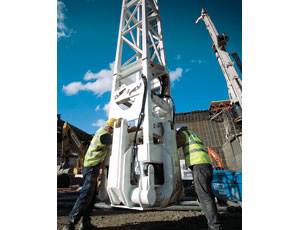British engineer Alex Cartwright had just three months to convert paper designs of a new-generation, column-plunging frame into a working tool for the foundations of London’s 310-meter-tall Shard, which will be Europe’s tallest building. Stressful weeks spent detailing and procuring two of the novel frames paid off: The sophisticated equipment accurately placed huge underground steel columns to support the Shard core’s top-down construction, helping to trim months from the project schedule.

Last year, Shard piling subcontractor Stent Foundations Ltd., Basingstoke, used the frames to lower steel columns through cased boreholes, with sections up to 60 cm x 60 cm, into wet concrete of pile tops some 15 m below the surface.
For the next few months, 23 of the plunged columns will support the core as workers below excavate the basement’s lowest floor. At the same time, a slipforming crew above them will be casting the core. In summer, with the core standing more than 30 floors tall, its bottom few meters will be completed, finally making the plunged columns redundant.

A civil engineer, Cartwright’s longtime interest in mechanical engineering helped him personally design a new-generation, columnplunging frame.
“We believe it’s the first time the core of a major building has been built top-down,“ says John Parker, technical director of WSP Cantor Seinuk, London, the Shard’s structural designer.
Cartwright effectively works alone through two London-based firms. He owns A.C. Devco Ltd. and co-owns Aperio Engineering Ltd. Among his prospects are potential international orders for more plunging frames, stimulated, he believes, by the Shard's high-profile.
Though used for many years, column-plunging technology has failed to keep up with demands for ever-deeper basements, says Cartwright. With fixed lengths of about 6 m, existing frames would have struggled to achieve tolerances such as the Shard’s, at 15 m below ground.
The main advantage of his modular frame is that “you can tailor the length...so you are always guiding the column at the lowest possible point, just above the concrete,“ says Cartwright. “We have a frame that can be adjusted effectively between 4.5 m and 26 m.“
Other novel features include vertical laser guidance. There are hydraulic arms that pivot from the frame’s top and bottom against the borehole casing, to firmly hold large columns in position with up to 10 tonnes of force.
Having designed, procured and managed operations of the plunging frames, Cartwright has been recruited to promote foundation services of a U.K. contractor in the U.S. But as an entrepreneur with a passion for designing equipment, he is keeping his own business going.


Post a comment to this article
Report Abusive Comment